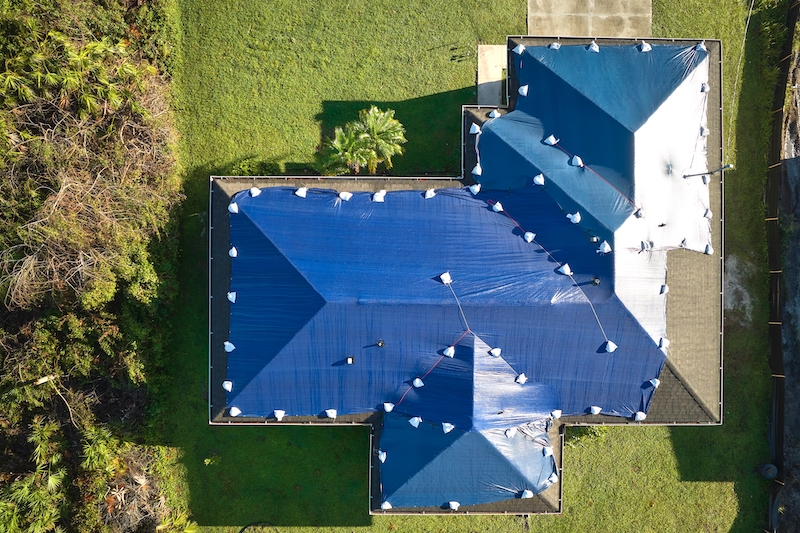During a recent conversation with a friend, they mentioned their concerns about the damage to their roof after a particularly nasty storm. They were unsure of how to protect their home from further harm and asked me if I knew anything about roof tarps.
I recalled my own experience dealing with storm damage in the past and how using a roof tarp saved my home from additional destruction. My friend’s question sparked an interest in sharing more information on this essential topic for homeowners similarly in need of roof tarping.
As a person with considerable knowledge of the building sector, I am aware of how crucial it is to give precise and dependable counsel when protecting one’s property. Let’s now delve into the specifics of roof tarps – their purpose, how to set them up for optimal security, and whether they are temporary or permanent fixes – as we consider what it takes to properly inspect and repair storm-related damage.
We’ll also discuss temporary solutions versus permanent repairs and highlight the importance of working with experienced professionals when dealing with storm damage inspection and repair services. So grab your toolbox, because we’re about to explore everything you need to know about keeping your home safe under challenging circumstances.
Table of Contents:
- The Necessity of Roof Tarps in Emergency Situations
- Types and Materials of Roof Tarps
- Temporary Solutions Before Permanent Repairs
- Professional Assistance for Roof Damage and Tarp Installation
- FAQs in Relation to Roof Tarps
- Conclusion
The Necessity of Roof Tarps in Emergency Situations
Living in South Florida has demonstrated to me the criticality of roof tarps for emergency situations. I’ve seen firsthand how they can be essential for safeguarding homes during emergency situations like hurricanes, tornadoes, high winds, and other extreme weather events.
These temporary coverings provide much-needed protection to damaged parts of a roof until more permanent solutions are put into place. They prevent further damage caused by exposure to the elements.
Common Emergency Situations That Warrant the Use of Roof Tarps
- Hurricanes and tropical storms with strong winds
- Tornadoes causing debris impact on roofs
- Hailstorms damaging shingles and tiles
- Fallen trees from heavy snowfall or ice accumulation
Installing a protective tarp quickly after experiencing hurricanes, tornadoes, or hailstorms is essential to avoid any extra harm while awaiting repairs.
Preventing Additional Damage with Timely Tarp Installation

I remember one time when we had some pretty severe thunderstorms roll through our area. My neighbor’s house suffered significant roof damage due to fallen tree branches – their entire living room was exposed. It was clear that they would have to have their entire roof tarped.
Luckily, they were able to get their hands on some blue vinyl tarps quickly enough so that they could cover up the hole before any rainwater made its way inside. If it weren’t for those trusty tarps providing immediate protection against inclement weather conditions like UV rays and torrential downpours – who knows how much more damage they would have sustained?
So, if you ever find yourself in a situation where your roof has been compromised by storm damage or other emergencies, don’t hesitate to reach out to a professional roofing contractor for help with emergency repairs and tarp installation. Trust me – it’s better to be safe than sorry when it comes to protecting your home from the elements.
Roof tarps are essential for safeguarding homes during emergency situations like hurricanes, tornadoes, and high winds. They provide much-needed protection to damaged parts of a roof until more permanent solutions are put into place, preventing further damages caused by water leaks or exposure to the elements. Installing a tarp as soon as possible after an event is crucial in preventing additional damage from occurring while waiting for repairs to be completed.
Types and Materials of Roof Tarps
I can personally attest to the necessity of possessing an appropriate roof tarp after enduring a hurricane’s aftermath. As such, choosing the right type of tarp is crucial.
So, what materials are used to make these life-saving tarps? There are two main types: polyethylene and vinyl.
Polyethylene vs. Vinyl Tarps
Polyethylene tarps, also known as “blue tarps,” are lightweight, water-resistant, and budget-friendly. They’re ideal for temporary fixes during emergencies like hurricanes or tornadoes.
On the other hand, vinyl tarps offer more durability and strength compared to polyethylene tarps. These heavy-duty tarps provide better protection against UV rays and are fire retardant, making them an essential feature if you live in areas prone to wildfires.
My suggestion is to go for a top-notch vinyl tarp, as it offers greater durability and protection than blue tarps. They’ll last longer than polyethylene tarps and provide better protection.
Hurricane Barrier Mesh Tarps
Beyond traditional blue or vinyl tarps, another option worth considering is Hurricane Barrier Mesh Tarps. These unique mesh fabric covers allow wind to pass through while still protecting your home from debris impact damage caused by strong winds during storms – pretty cool, right?
Now that you know the different types of roof tarps available and their materials, it’s time to think about which one suits your needs best. Consider factors like the severity of weather conditions in your area and how long you expect to use a tarp before permanent repairs can be made.
Remember my hurricane experience? I wish I had known more about roof tarps back then. Armed with this understanding, I’m better ready for any potential future hurricanes or crises that could come our way.
Don’t wait until disaster strikes; equip yourself with the right type of roof tarp today.
Choosing the right type of roof tarp is crucial for protecting your home from damage caused by natural disasters. Polyethylene tarps are budget-friendly and ideal for temporary fixes, while vinyl tarps offer more durability and strength. Hurricane Barrier Mesh Tarps are a unique option that allows wind to pass through while still protecting your home from debris impact damage during storms.
Proper Installation Techniques for Roof Tarps
As someone who has experienced the aftermath of a severe storm, I know firsthand the importance of installing roof tarps correctly. In order to prevent further damage to your home, it is essential to act quickly in getting your roof tarped. Here are some essential steps to follow:
Assessing Damage Before Installing a Tarp
Before installing a tarp, inspect your roof thoroughly to determine the extent of the damage. If uncertain of one’s ability to handle the repairs, it is recommended to contact a certified roofing specialist. Safety should always be your top priority.
Safety Measures When Working on Rooftops
Before ascending onto the rooftop, make sure you have all necessary protective equipment, such as gloves, non-slip shoes, and safety harnesses. Ensure that ladders are secured properly and have someone available to assist if needed. If possible, wear a helmet as well.
Now, let’s move on to the installation process:
- Carefully unfold the tarp over the damaged area, ensuring full coverage;
- Tightly secure one end of the tarp using wooden boards (2x4s) nailed or screwed into place;
- Pull the other end tight across the entire length before securing it in the same manner;
- Add bungee cords or zip ties along the edges for extra support;
- Finally, place sandbags or anchor boards around the perimeter to prevent wind from lifting the tarp.
Remember that proper installation is key for your roof tarps to effectively protect your home from further damage.
A Word of Caution: DIY vs. Professional Help
While I managed to install my roof tarp successfully on my own, it’s not always advisable. If you’re unsure about any aspect of the process or if the damage is extensive, don’t hesitate to call a professional roofing contractor like J&R Restoration for help.

Their expertise in dealing with storm damage and emergency repairs can save you time and money while ensuring safety during inclement weather conditions.
It’s worth noting that a well-installed roof tarp can last up to 90 days.
To sum it up – proper installation techniques are crucial when using roof tarps as temporary solutions after storms or other emergencies. Stay safe and take necessary precautions while working on rooftops, especially if you need to have your entire roof tarped.
Proper installation techniques for roof tarps are crucial to prevent further damage to your home after a severe storm. Before installing the tarp, assess the damage and ensure you have all necessary safety gear and equipment. If unsure about any aspect of the process or if the damage is extensive, it’s best to call a professional roofing contractor for help.
Temporary Solutions Before Permanent Repairs
I’m familiar with the aggravation of a damaged roof after a storm and am aware of how essential it is to seek an expeditious solution. Roof tarps, including the cheap blue ones, are an excellent temporary fix for situations like these. They can last up to 90 days, but it’s crucial not to rely solely on them. Let me explain why.
When is it time to replace your temporary tarp?
It’s essential to keep an eye on your temporary tarp. If you notice any tears or fading, it’s time for a replacement. Tears can compromise the effectiveness of the tarp by allowing water leaks and exposure to UV rays. Fading indicates that the material has weakened due to prolonged sun exposure and may no longer provide adequate protection against inclement weather conditions such as strong winds or heavy rainfall.
Planning for Permanent Roof Repairs
From my experience, waiting too long before scheduling permanent repairs can lead to more significant issues down the line. So how do we avoid this? Firstly, schedule regular inspections with a professional roofing contractor who specializes in emergency repairs during mild weather conditions (think sunny days). Secondly, contact your insurance company promptly after discovering damage so they can assess whether it falls under their coverage policies – this will help speed up repair processes considerably.
Maintaining a Proactive Approach
It’s crucial to maintain a proactive approach when dealing with roof damage. By addressing issues as soon as they arise, you can prevent further complications and expenses. Gain an understanding of the various roofing materials available and their respective benefits and drawbacks to make informed decisions when it comes time for repair or replacement.
Roof tarps are a great temporary solution for damaged roofs, but it’s important to keep an eye on them and replace them if necessary. It’s crucial to plan for permanent repairs by scheduling regular inspections with a professional roofing contractor and contacting your insurance company promptly after discovering damage. Maintaining a proactive approach is key, but always prioritize safety when dealing with roof work.
Professional Assistance for Roof Damage and Tarp Installation
I remember the time when my roof was severely damaged after the hurricane. I thought I could handle it myself, but soon realized that some situations call for professional help.
Identifying when professional help is needed

If you suspect roof damage after a storm or if the damaged area is not easily accessible, don’t hesitate to call professionals for an inspection. They have the expertise and equipment necessary to assess your situation accurately.
You may think you can manage on your own, but trust me – it’s better to be safe than sorry. In my case, calling in experts saved me from potential injuries and further damage to my home.
- Do you observe any indications of destruction?
- Is water leaking into your home?
- Do you feel confident working at heights?
If you answered “no” to any of these questions, consider seeking assistance from a professional roofing contractor.
Services offered by roofing companies in emergency situations
In times of crisis like mine, companies like J&R Restoration provide thorough storm damage repair services that include inspections and damage analysis reviews. Their team will assess the extent of damages before recommending appropriate solutions such as installing roof tarps or performing emergency repairs.
The Importance of Properly Installed Roof Tarps
When it comes to installing roof tarps, the quality of workmanship is crucial. A poorly installed tarp can cause more harm than good, leading to additional damages and costly repairs.
This is where professional roofing contractors come in handy – they have the experience and skills necessary for proper installation, ensuring your home remains protected until permanent repairs are made.
Fire Retardant Tarps: An Added Layer of Protection
If you’re dealing with fire damage as well, consider using fire retardant tarps. These specialized tarps not only protect against water infiltration but also help prevent fires from spreading further.
When dealing with roof damage, it’s important to know when to call in the professionals. Roofing companies offer emergency services such as inspections and tarp installation for temporary protection until permanent repairs can be made. Properly installed tarps are crucial for protecting your home from further damage, and fire retardant tarps provide an added layer of protection against fires.
FAQs in Relation to Roof Tarps
Should You Put a Tarp on Your Roof?
Yes, installing a tarp on your roof is recommended in emergency situations such as after storm damage or when there’s a leak. A properly installed tarp can help prevent further water intrusion and protect the interior of your home from additional damage until professional repairs can be made. FEMA also recommends using tarps for temporary protection.
Why Do People Have Tarps on Their Roofs?
People use tarps on their roofs to provide temporary protection against leaks, water damage, and other issues caused by damaged roofing materials. Tarps are commonly used following storms or natural disasters that cause significant roof damage before permanent repairs can be completed. They serve as an effective short-term solution to minimize further damage.
What Type of Tarp Is Best for a Roof?
The two most common types of tarps for roofing are polyethylene and vinyl. Polyethylene tarps are lightweight, waterproof, and cost-effective but may not last as long as vinyl options. Vinyl tarps offer better durability and UV resistance but tend to be more expensive. The choice depends on factors like budget, expected duration of use, and severity of the situation.
Does Tarping a Roof Cause Damage?
Tarping itself does not typically cause any additional harm if done correctly; however, improper installation could potentially lead to problems such as puncturing shingles or causing stress points due to excessive tension. It’s crucial to follow proper installation techniques and secure the tarp using nails on uncompromised areas of the roof.
Conclusion
From this article, we have learned that roof tarps are essential in emergency situations. Installing a tarp promptly can prevent additional damage from occurring and protect your home’s interior.
Choosing the right material for your tarp is crucial, with factors such as durability and weather resistance to consider. Proper installation techniques involve assessing the damaged area before securing the tarp using nails on uncompromised areas of the roof.
For a lasting solution to storm damage, it is best to seek professional help for inspection and repair services. While temporary solutions like blue roofing tarps may last for some time, identifying signs that indicate professional repair services are necessary will save you money in the long run.
If you need help with installing a roof tarp or repairing any damages caused by storms or other emergencies, including mold issues, fire damage, or water damage, contact J&R Restoration.


